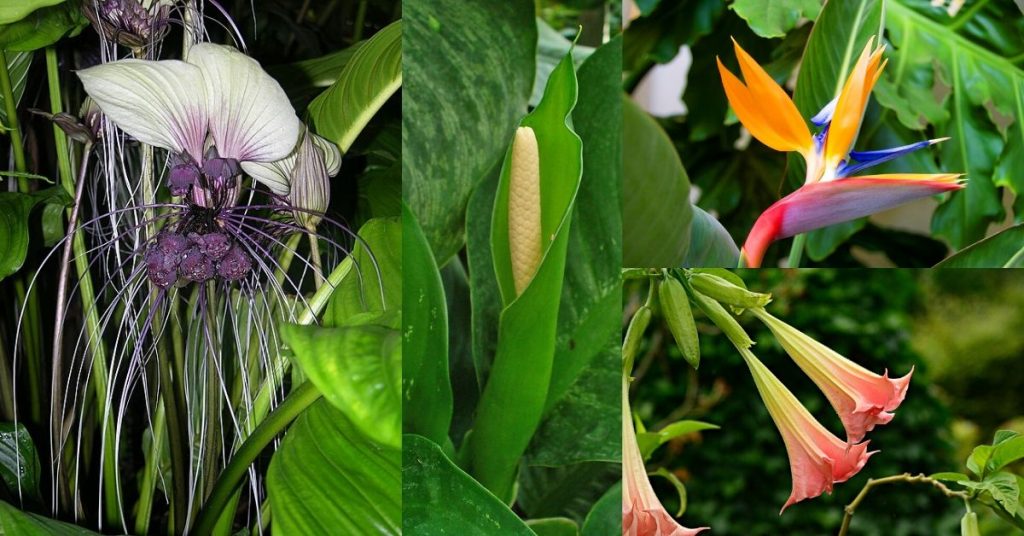Do you love tropical weather? What about tropical flower plants and places you can visit? Does it remind you of the beautiful and warm sunny days with the clear blue sky? Tropical plants and flowers are just so unique and interesting to look at.
- Asclepias Curassavica
- Brugmansia X Candida
- Canna 'Striata’
- Colocasia Esculenta
- Cuphea 'David Verity’
- Euphorbia Cotinifolia
- Ipomoea Batatas
- Manihot Esculenta 'Variegata'
- Musa Basjoo
- Salvia Splendens
- Anthurium
- Bird of Paradise
- Cordyline Fruticosa
- Ficus
- Palm Trees
- Dieffenbachia Seguine
- Spathiphyllum
- Croton
- Aloe Vera
- Ficus Elastica
- Sansevieria Trifasciata
- Philodendron Hederaceum
- Schefflera Arboricola
- Aglaonema Commutatum
- Monstera Deliciosa
- Tacca Integrifolia
- Psychopsis Papilio
- Saintpaulia Ionantha
- Gaillardia
- Amaryllis
- Caladium Bicolor
- Chlorophytum Comosum
- Yucca Elephantipes
- Araucaria Heterophylla
- Begonia
- Medinilla Magnifica
- Calliandra Haematocephala
- Zamioculcas Zamiifolia
- Crassula Ovata
- Epipremnum Aureum
- What Are Some Other Tropical Flowering Plants to Grow?
- Which of These Tropical Flowering Plants is Best For You?
In this guide, you’ll find a list of our selected tropical flowering plants that come from many tropics include the Equator and other parts of North and South America, Hawaii, Africa, Australia, and Asia.
These unusual flowers are so fascinating, exotic and sometimes even weird to observe. They come in many different colors including red, green, orange, purple, pink, white, etc… and can be found in both gardens and rain forests.
Asclepias Curassavica
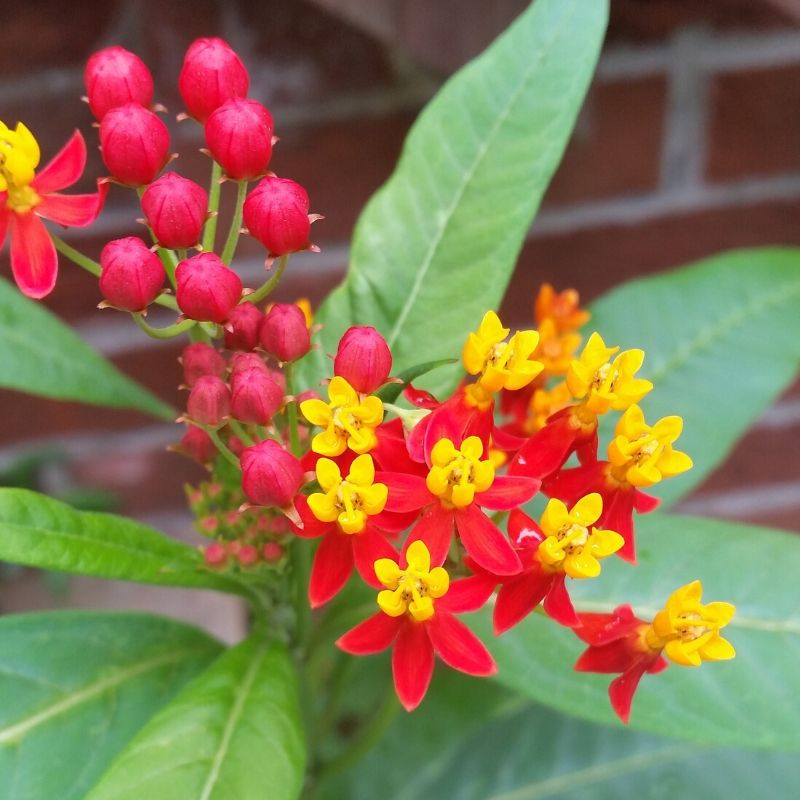
The Asclepias curassavica or blood flower is a tropical plant that originated in South America and is a member of the Apocynaceae family. It is also known as scarlet milkweed, swallow wort, matal, Indian root, Mexican butterfly weed and tropical milkweed.
Blood flowers are perennials evergreens and grow approximately 2 to 3 feet in height. Easily started from seeds, the blood root can be grown for gardens, cut flowers, or walkways.
The Asclepias curassavica draws hummingbirds, bees and butterflies to its bright red-orange or yellow star-shaped flowers. The small flowers form clusters and bloom from June to October. Monarch Butterflies lay eggs under the leaves which hatch and eat the leaves. The plant is considered poisonous to livestock.
Brugmansia X Candida
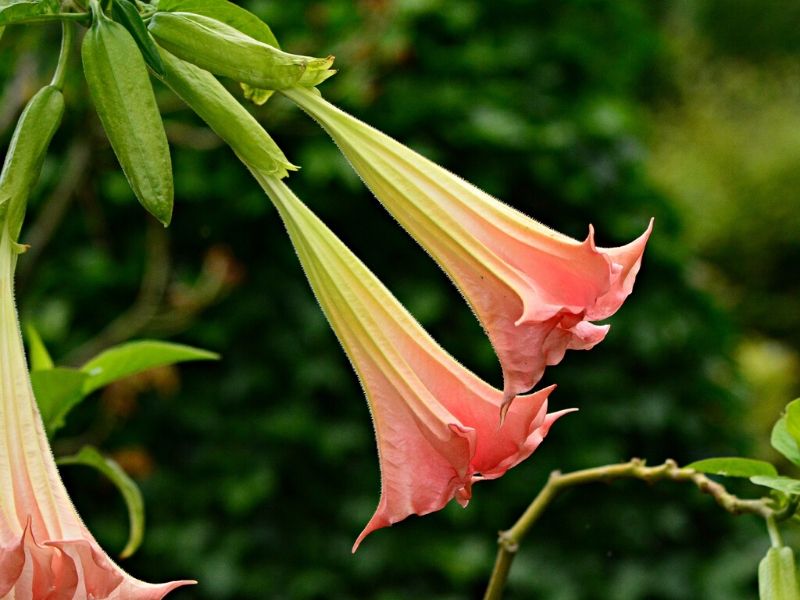
The Brugmansia plant (also known as Angel’s trumpet) is a wide-leafed evergreen native to Ecuador. In areas with colder climates, the plant may be potted and taken inside or mulched for winter dormancy.
It is a member of the Solanaceae family and grows best in full sun, requiring fertilizer during peak blooming cycles. The Brugmansia plant reaches maturity between 5 and 6 feet in height and circumference and is considered a small tree or shrub.
The flowers of the Brugmansia are attractive and have a pleasing fragrance. The fragrant flowers are trumpet-shaped and open near sunset. Most blossoms are singles, but there are double blossom varieties available. Flowers come in shades of pink, gold, white or orange. The plant is a rebloomer with short cycles of 4 to 6 weeks.
Canna ‘Striata’
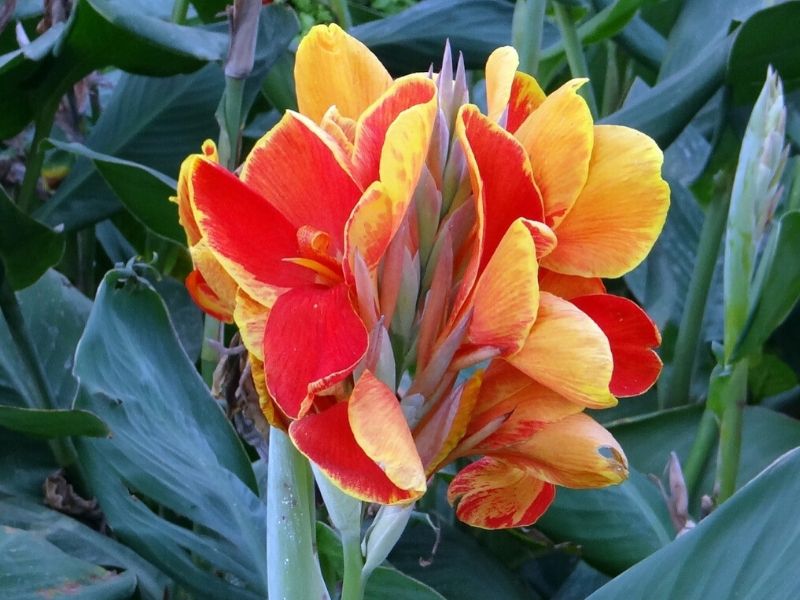
The Canna plant is hardy annual and member of the Cannaceae family. It is grown from bulbs which should be dug up for winter months and stored inside. The Canna plant typically grows to heights between 4 and 6 feet, spreading from approximately 2 to 4 feet. Cannas grow best in full sun and are considered low maintenance plants.
The Canna plant has large spade-shaped variegated leaves that come in different shades, some with stripping. The stems of the plant contrast well with purple-tones. Orange flowers form on tall, straight stems that are surrounded with leaves. Cannas bloom during the months of July and September.
Colocasia Esculenta
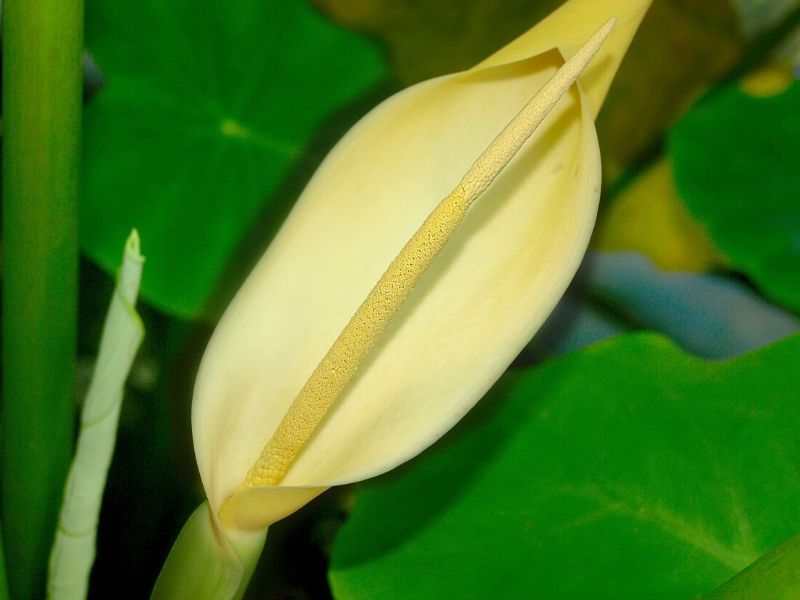
The Taro plant is a member of the Hraceae family and is grown from bulbs called tubers. In non-tropical regions with temperatures nearing freezing or below, tubers should be dug up and stored inside. In Hawaii, taro is grown commercially as a food crop. Tubers are harvested for making “poi”.
Taro is also known as an elephant ear, jack-in-the-pulpit, or calla lily plant. It is mainly planted for its foliage and comes in a variety of cultivar types sporting colors in tones of black and yellow, purple hues, traditional green, and black to chocolate. Taro flowers are white with yellowish markings and bloom during July and August.
Cuphea ‘David Verity’
Cuphea ‘David Verity’ is an herbaceous broadleaf evergreen perennial and member of the Lythraceae family. Commonly planted is the cultivar Cuphea ignea.
The plant requires little maintenance and is grown in gardens, borders, hanging baskets and as a household plant. The plant forms a circular bush approximately 2 feet in height with the same spread.
Cuphea attracts butterflies and hummingbirds. The plant establishes quickly and blooms throughout the summer months. Flowering is prolific and eye-catching with dozens of reddish-orange inch long, yellow-tipped tubular blossoms.
Euphorbia Cotinifolia
The Euphorbia plant originated in South American and Mexico. It is a member of the Euphorbiaceae family and also known as smoketree spurge, tropical smoke brush or Caribbean copper plant.
Labeled as a broadleaf evergreen, the Euphorbia plant grows best in full sun. The smoketree spurge is grown as a shrub growing in heights of 2 to 6 feet but may grow as high as 30 feet when trained as a tree.
The Euphorbia plant has a thick milky sap that can irritate the skin and cause a rash. This plant has definite eye appeal with delicate leaves in tones of purple and red. Tiny white flowers appear in the later days of summer. They can also be more creamy in color.
Ipomoea Batatas
Ipomoea batatas plant is commonly known as the sweet potato plant and a member of the Convolvulaceae family. Sweet potato plants grow from tubers and are native to Mexico. The plant is vine-like, growing in heights of only 6 to 12 inches, with a spread from 8 to 10 feet.
The vines produce nodes which root, producing the common orange fleshy sweet potato that is used commercially for food. Commercial varieties have green leaves and occasionally produce light pink or purple trumpet-shaped flowers.
The Ipomoea plant is a low maintenance plant that grows best in direct sun. Ornamental varieties are colorful with heart-shaped leaves with tones of green, red and purple. These varieties do not blossom but do produce edible tubers, but the flavor is not as sweet as the food variety.
Manihot Esculenta ‘Variegata’
Manihot esculenta plant originated in Brazil as a member of the Eurphorbiaceae family. It is known as bitter cassava, tapioca and manioc and grows as an annual in direct sunlight to partial shade.
Tuberous roots grow similar to the sweet potato plant and are used as a food source. A sweet variety is grown as a vegetable and a bitter type is used to produce starch. Tubers contain hydrocyanic acid which is poison and must be removed prior to consumption.
The plants flourish in humidity and heat and grow from 3 to 10 feet in height. Leaves are variegated with yellowish to white centers with bright green edgings. Stems are red. The bitter cassava produces attractive greenish-white flowers.
Musa Basjoo

The Musa basjoo (hardy banana) is an herbaceous perennial and belongs to the Musaceae family. Usually grown as an accent plant for its characteristic tropical foliage, the Japanese banana is native to Japan and the Ryukyu Islands.
The Ryukyu Islands’ variety plant thrives in cooler climates, but other varieties are not cold hardy, and therefore intolerant of frost. Japanese bananas are fast-growing plants that do best in full sun with periods of partial shade.
The Musa basjoo grows from 6 to 14 feet yearly on a pseudo-stem formed by leaf sheaths. Growing from a rhizome, the Japanese banana needs shelter from strong winds and plenty of space for optimal growth.
The leaves are quite large, up to 6 feet, and come in different colors from green to variegated. In the early fall, yellow creamy flowers bloom near the base of the plant. Inedible green bananas will follow giving the Japanese banana exotic appeal.
Salvia Splendens

Salvia splendens is a low maintenance herbaceous perennial originally from Brazil. Belonging to the Lamiaceae family, it is popularly grown as an annual due to its prolific and vibrant flowering from June until the first frost. The plant attracts butterflies, birds and hummingbirds.
Salvia splendens grows well in containers or gardens. They are quite spectacular when used in container gardening. It also makes a vibrant cut flower. Also known as scarlet sage, it comes in variety of cultivators with average heights of 3 to 4 feet that spread forming clumps of similar dimensions.
Traditional Scarlet sage produces bright red long tubed blossoms on straight square stems with dark green leaves. Today, cultivators come in a multitude of colors from bicolor, scarlet red, blue, lavender, orange and pink.
Anthurium
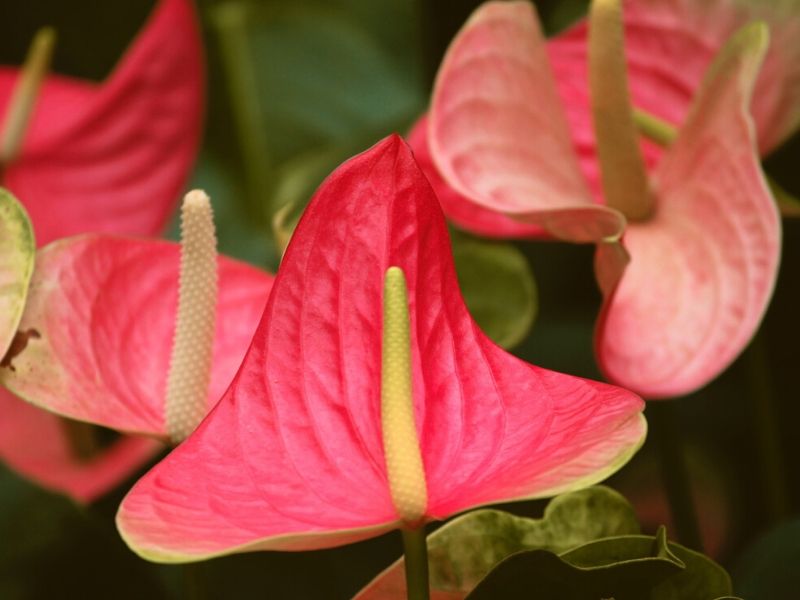
Anthurium is a member of nearly 1000 species of Aracea family. Native to the Windward Islands, Colombia, Venezuelan Antilles and Ecuador, Anthurium is a beautiful indoor tropical plant that produces best results in humid, well-lit locations.
Also known as painter’s palette, flamingo lily, flamingo flower, tailflower and laceleaf, Anthurium produces showy flowers in brilliant waxy red to shades of red. The majestic flamingo flowers grow on yellowish spadix or spikes. Leaves are heart-shaped. With optimal growing conditions, flowers appear all year. Blooms are also used in arrangements.
Anthurium produces a sap that can cause skin irritations, and all parts of the plant are poisonous.
Bird of Paradise
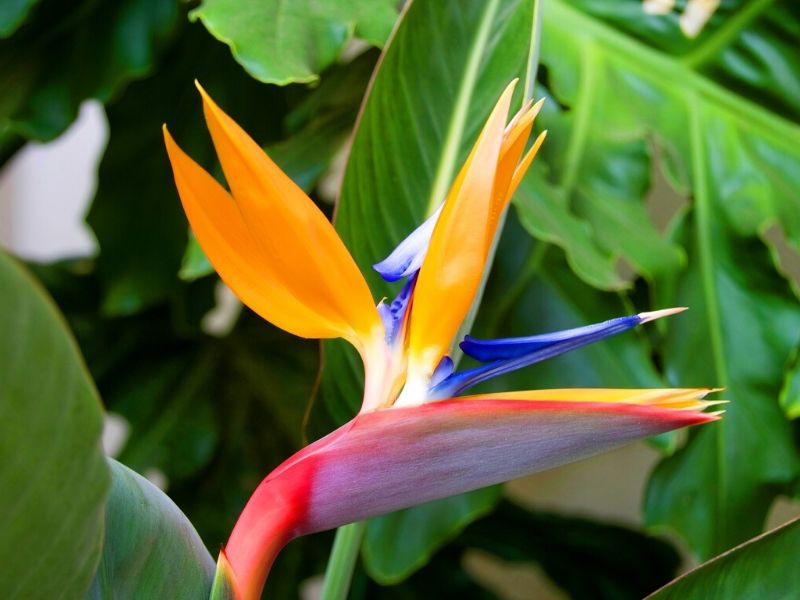
Bird of Paradise strelitzia, originating in South Africa, are called crane flowers or orange strelitzia. The plant gets his name because the flowers appear similar to a “bird in flight”.
A member of the Strelitziacea family, Bird of Paradise plants grow well indoors or out. They are relatives of the banana plant and are intolerant of freezing temperatures.
Crane flowers are unusual in that banana-shaped leaves sprout from the soil without the need for a stem. Leaves mature and toughen on sturdy leaf stalks.
The plant grows in 3 to 5 foot clumps, and flowers bloom randomly in showy colors of orange and blue approximately 6 inches wide and 18 inches in length. Bird of Paradise may be grown from seeds but require 3 to 5 years for maturity and blooming. Dividing the plant clumps is recommended.
Cordyline Fruticosa
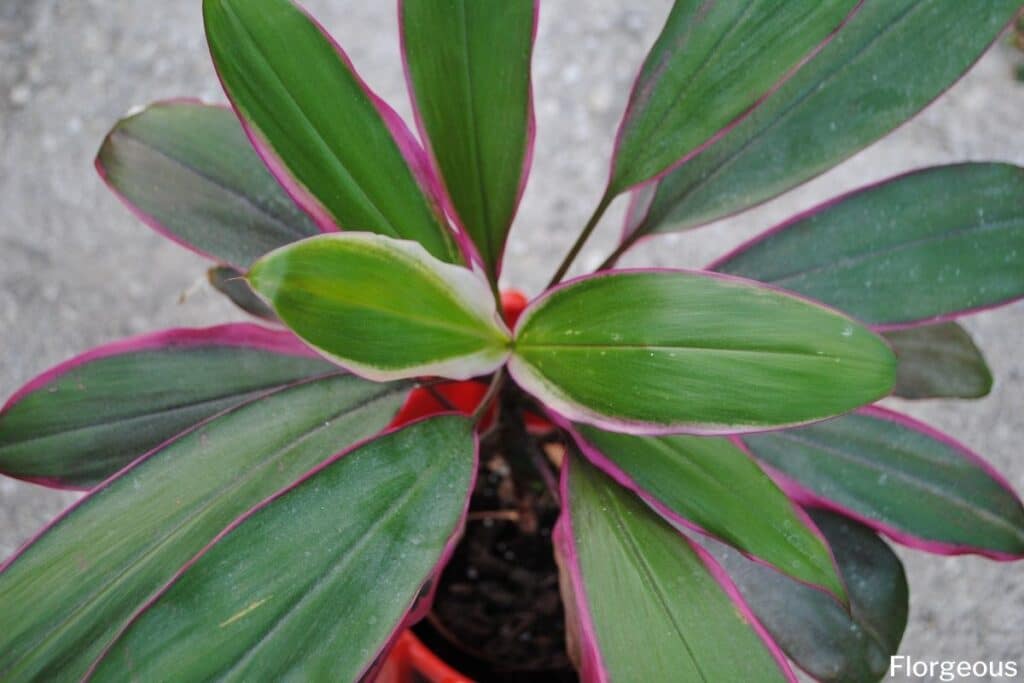
Cordyline fruticosa is a type of Ti plant native to Eastern Australia, Eastern Asia, and Hawaii. It is a member of the Asparagacea family and a broadleaf evergreen.
Also called the Ti Plant or cabbage tree, native varieties grow as shrubs or small trees ranging in heights from 9 to 15 feet with spreads of 3 to 8 feet. Modern cultivars are attractive palm-like beauties and recommended as flowering trees or indoor house plants requiring medium amounts of care.
Cordyline fruticosa grows from rhizomes which are edible and used as a food source in Hawaii. The leaves are sword-shaped and easily fashioned into hula skirts. When leaves first sprout, they are shades of pink turning to red but mature deep green. Scented flowers bloom in white to light lavender, with red berries following.
Ficus
Ficus is a tropical evergreen and member of the 850 species Moraceae family which includes shrubs, vines and woody trees.
Commonly known as a weeping fig, it is native to regions from India to Northern Australia. In the rain forests, weeping figs grow to heights of 50 feet, have simple waxy leaves and produce flowers that require specific wasp pollination with the development of figs following.
Ornamental ficus is grown as small trees, hedges and house plants. The weeping fig requires full sun to part shade and requires low maintenance. As an indoor plant, it seldom flowers and cannot produce fruit due to pollination requirements.
Palm Trees
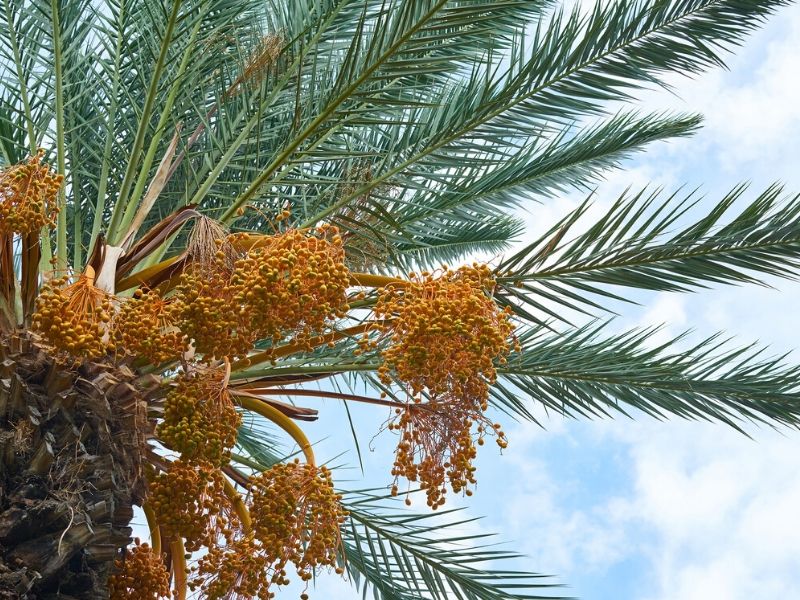
Palm trees are perennial members of the Arecaceae family. Found originally in regions with tropical climates, the most commonly known types are the coconut and date palm.
Other varieties are shrubs and climbers. Palms have the ability to withstand floods and strong winds. The plant grows straight with no branches and the girth of the plant grows to its maximum circumference before it grows in height.
Palm tree bark can be smooth to armored. The foliage is fan-shaped and green. Palms have numerous commercial and ornamental uses.
Dieffenbachia Seguine
Dumb Cane or Dieffenbachia seguine is a tropical flowering plant and member of the Araceae family. A native plant of Brazil, Dumb Cane’s sap can cause skin rashes or irritation.
The entire plant is poisonous to pets and humans. In the tropics, Dumb Cane thrives in partial sun to full shade, grows to heights of 10 feet and blooms seasonally. They do best of exposed to morning sun instead of the harsh midday sun.
Indoor cultivars are prized as ornamentals due to lovely variegated cream, yellow to green variegated foliage and attractive white flowers. Flowers are followed by eye-catching red berries. The plant likes low light.
Read more: Dieffenbachia Varieties and Types of Dumb Cane Plants to
Spathiphyllum

Peace Lilies or Spathiphyllum have become popular ornamental plants in public spaces due to the theory that they have the ability to clear the air by removing “vaporized solvents.” They are also valued for their beauty and ease of flowering in medium light.
As members of the Araceae family and perennials, Peace Lilies grow in shady to partially shady locations. Cultivators come in heights from 1 to 6 feet with spreads of 1 to 5 feet.
Care requirements are minimal. Leaves are bright green and glossy, clustering around splashy snow-white flowers. In about a week, flowers will mature to light green.
Croton

Croton or Joseph’s Coat is a perennial with a woody type stem. Grow originally in the Pacific Islands, Malaysia and northern Australia, it has become a popular ornamental houseplant.
It is a member of the Euphorbiaceae family and broadleaf evergreen. Its ornamental appearance is largely due to the vividly colored foliage containing irregular splashes of green, pink, yellow, red, orange, purple and bronze.
The leaves are shiny, tough, and have even edges. There are often splotches or even stripping in the color patterns. Crotons grow well outdoors during warm months and require medium care.
Aloe Vera
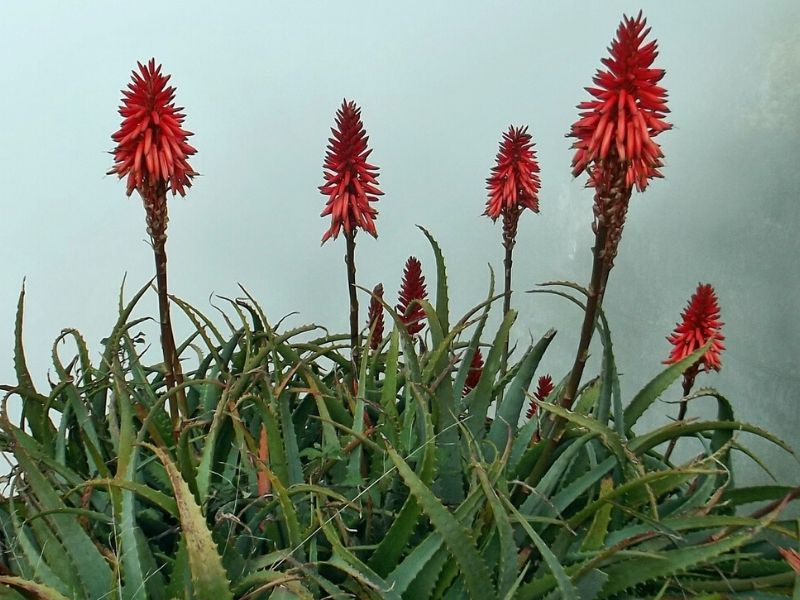
Aloe Vera plant is a tropical herbaceous perennial and has been nicknamed aloe or medicinal aloe. It is a member of the Asphodelaceae family and originated in the Mediterranean.
For centuries, Aloe Vera has been used for natural healing purposes due to the healing properties of the sap. Today, the sap is harvested for use in cosmetics such as lotions for its ability to moisten or heal dry skin. The sap may also be applied directly from the plant to burns.
Aloe is a drought tolerant evergreen that enjoys full sun and requires little maintenance. Aloe Vera is a stemless stoloniferous plant that reproduces from stolons or runners appearing at ground level.
Succulent leaves of the aloe are green and lance-shaped, forming clusters. Plants grow to heights of 1 to 2 feet and spread between 6 and 12 inches. Mature plants produce yellow flowers on 3 foot stalks during summer months.
Ficus Elastica
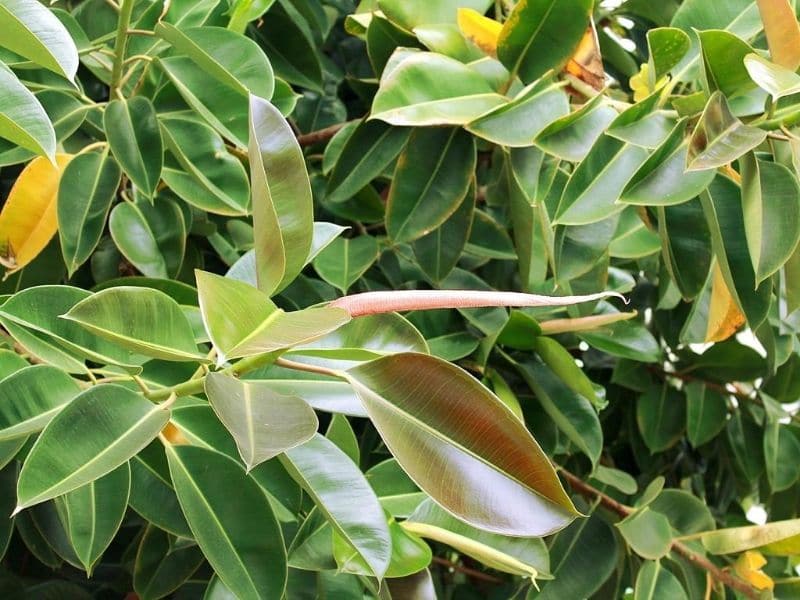
Ficus Elastica or rubber tree plant is also known as the rubber bush, rubber fig or India rubber tree. This ficus is a member of the Moraceae family and native to Southeastern Asia.
In the wild, rubber trees grow to heights of approximately 100 feet with similar spreads. Leaves are glossy dark green and thick while root systems are aerial similar to the banyan tree.
Ornamental cultivars grow to more manageable heights of 1 to 10 feet. Leaves are large, about 5 inches wide and 12 inches long.
The small trees grow in low light with minimal care and have become popular house plants. Foliage is appealing and comes in a variety of colors from green to reddish black or burgundy to purplish to variegated shades of yellowish green.
Sansevieria Trifasciata
Sansevieria trifasciata is a common indoor plant that does well in outdoor shady locations during the summer months. Originating in western Africa, it is an herbaceous perennial and member of the Asparagaceae family.
Sansevieriatrifasciata is nicknamed viper’s bowstring hemp, snake plant, Saint George’s Sword and mother-in-laws’s tongue. Maintenance and care requirements are low with house plants preferring sunny locations.
Snake plants are stemless evergreens that grow between 3 and 4 feet and spread between 1 to 2 feet. Foliage is straight, thickset and resembles rosettes or swords. Coloring is shades of light to dark green with lighter shading on the edges.
Plants grow easily from cuttings or by separating rhizomes from a mature plant. At maturity, plants produce scented greenish-white flowers in spring.
Philodendron Hederaceum
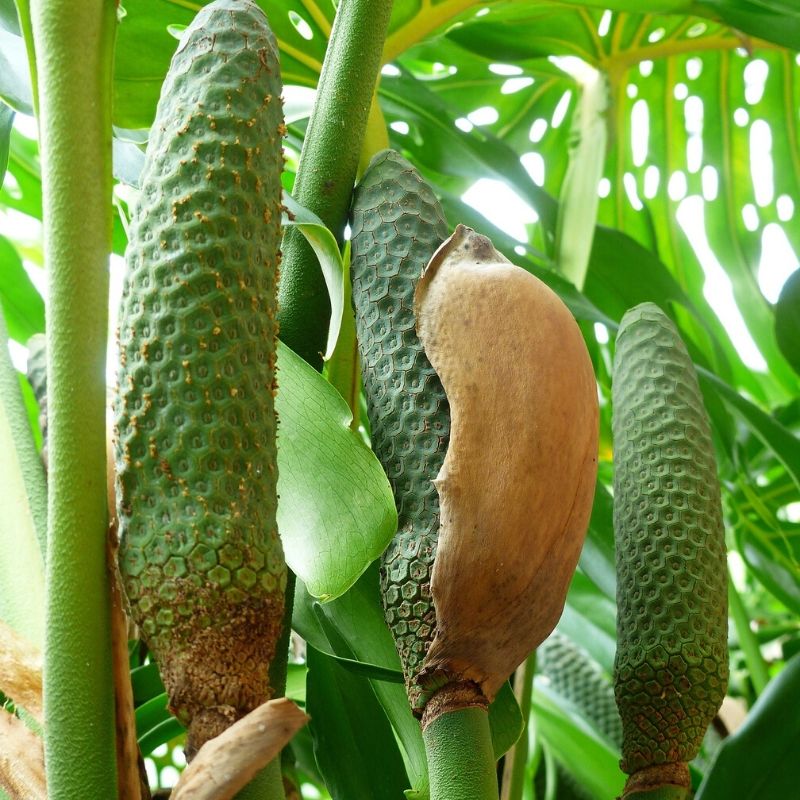
Philodendron hederaceum is a twining vine plant and member of the Araceae family. It was originally found in Central and South America, Mexico and regions of the Caribbean.
In nature, Philodendrons may reach heights of nearly 20 feet with spreads between 3 and 6 feet. Houseplant cultivars generally reach about 4 feet in height with the most popular cultivar being the heart leaf Philodendron.
Optimal growing conditions for vilevine include regular watering and indirect light. Plants have heart-shaped leaves that are dark green and shiny with new leaves being yellowish-brown in color.
Immature plants have leaves of about 4 inches and grow to approximately 12 inches when mature. Vilevine has twining stems that will wrap and climb when given support. Greenish-white flowers are produced on mature plants with optimum conditions.
Schefflera Arboricola
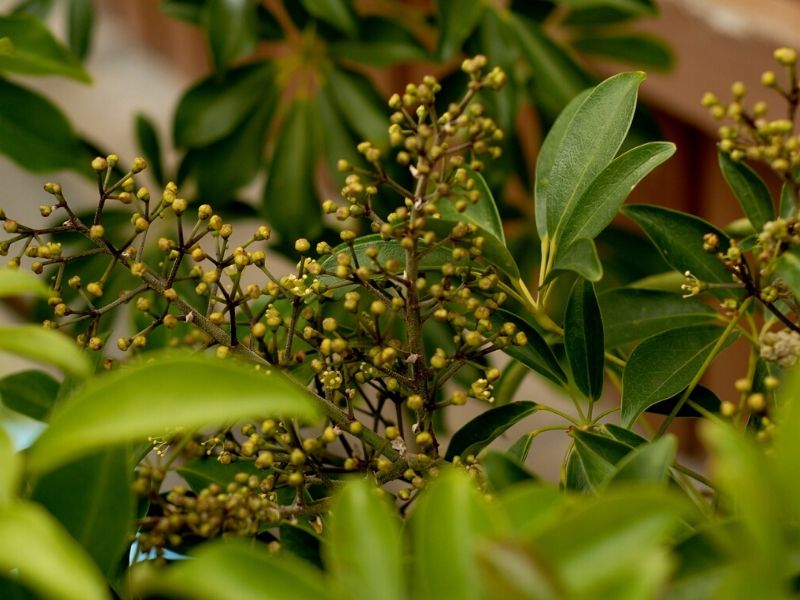
Schefflera arboricola is a tropical tree that is indigenous to Hainan and Taiwan. It is a member of the Araliaceae family and also known as Heptapleurum Arboricola, umbrella plant or dwarf schefflera.
In its natural habitat, the umbrella tree may grow to heights of 25 feet and spread 4 to 8 feet. It is a broadleaf evergreen that grows best in partial shade to full sun.
Ornamental cultivars may be used as dwarf trees, hedges or potted plants with heights ranging from 3 to 6 feet. These are easy to care for and tolerate winter temperatures.
Outdoors the umbrella plant develops tiny red flowers during the summer months. Gleaming leaves about 6 inches long circle around the leafstalk in groups of 7 to 9.
Aglaonema Commutatum
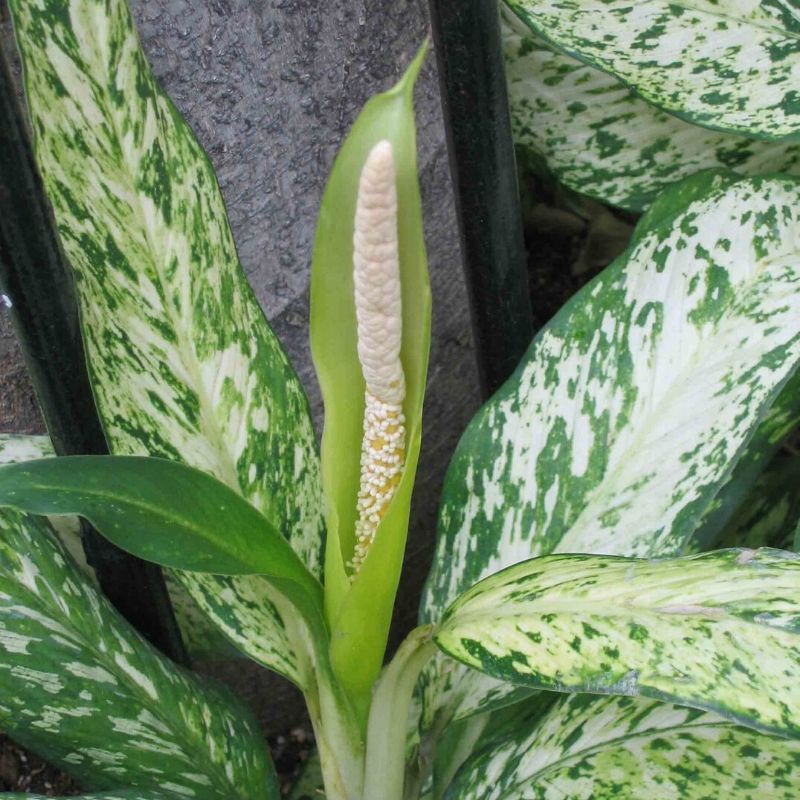
Aglaonema commutatum is a tropical evergreen perennial indigenous to the Philippines. It is a member of the Aracea family and is similar to Dumb Cane.
Aglaonema commutatum is also known as Chinese evergreen or Philippine evergreen. Philippine evergreen is intolerant of temperatures below 60 degrees Fahrenheit, but it is an easy-to-care-for plant that has no serious disease issues. Philippine evergreen does best in shady locations.
Ornamental house plant varieties generally do not bloom. Flowers of outdoor varieties develop an ivory-white blossom on a spadix that is covered with a light green spathe.
Following the flowers are bunches of red berries. The leaves of the Aglaonema commutatum are spear-shaped and dark green with splashes of gray.
Monstera Deliciosa
Monstera deliciosa is an evergreen vine plant and member of the Araceae family. Indigenous to Central America and Mexico, it is also called tarovine or split-leaf philodendron.
As a native plant, Monstera deliciosa vine wraps around trees, attaching itself with aerial roots and covering the trunk with huge 1 to 3 foot leaves. The tarovine may reach heights up to 70 feet and does best in partial shade.
Ornamental tarovines reach about 6 to 8 feet in height. Mature leaves are notched and a deep emerald green color. Care requirements are low.
Tacca Integrifolia
Tacca integrifolia (white batflower) is a tropical perennial that originated in Central Asia. This is one of the very weird types of tropical flowers. Most tropical flowers have a more traditional shape, but not this one.
Flowers are thought to bear a resemblance to bats; thus, it is nicknamed the bat flower or bat plant. It is a member of the Dioscoreaceae or yam family and grows from rhizomes.
Plants may be planted by separating rhizomes or by seeds. The bat plant matures to a height of 2 to 4 feet with a spread of 1 to 2 feet. Care requirements are high.
Ornamental cultivators are prized for their unique flowers and foliage. Blooms occur during mid to late summer and appear purplish, reddish, or brown. The flowers are attached to a single stem and spread in groups of about 30.
Psychopsis Papilio
The Psychopsis papilio or butterfly orchid is a tropical beauty indigenous to areas in South America, including Trinidad. It is a member of the 4 species Asparagales family.
In the rainforest, butterfly orchids grow on other plants and are termed epiphytic orchids. They take their nutrients from materials on the other plant’s surface, air, and moisture.
Butterfly orchids have wispy roots that like to remain moist but need to almost dry between watering. The leaves are single and vertical with hues of deep green and burgundy speckling.
Flowers are single in nature and form on a spike. Large flowers resemble a butterfly and come in colors of yellow, bronze, and brown.
Saintpaulia Ionantha
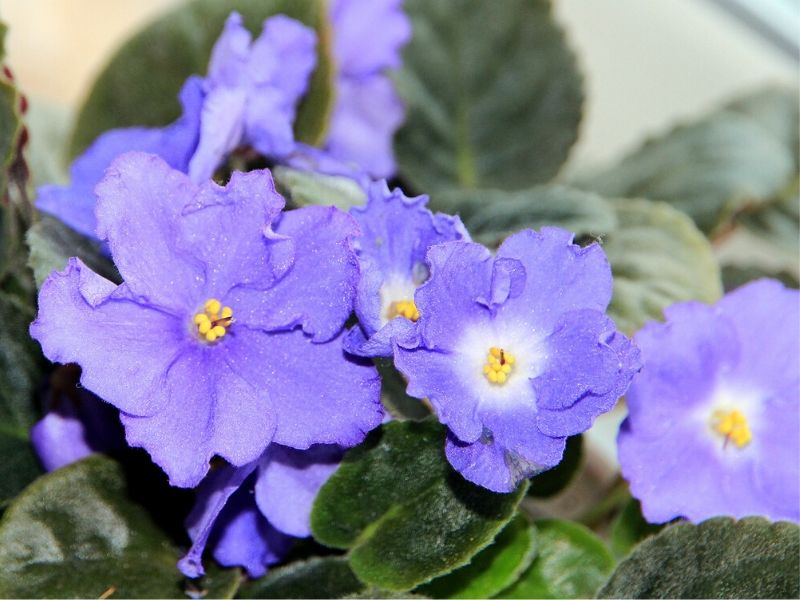
Saintpaulia ionantha or African Violet is a tropical flowering plant native to Tanzania. It is an herbaceous evergreen perennial and a member of the Gesneriaceae family.
African violet grows best indoors and in greenhouses, requiring temperatures between 60 degrees and 85 degrees Fahrenheit for optimal growth and blooming. African Violets also need indirect light and dry air.
With proper care, African Violets produce blooms throughout the year. They are small plants with stocky, dark green leaves covered in wispy hairs.
Common colors include blue-violet, white, purple and pink. Flowers come in singles petals, semi-double petals, and double petals. Plants grow between 6 and 9 inches with the same spread.
Gaillardia
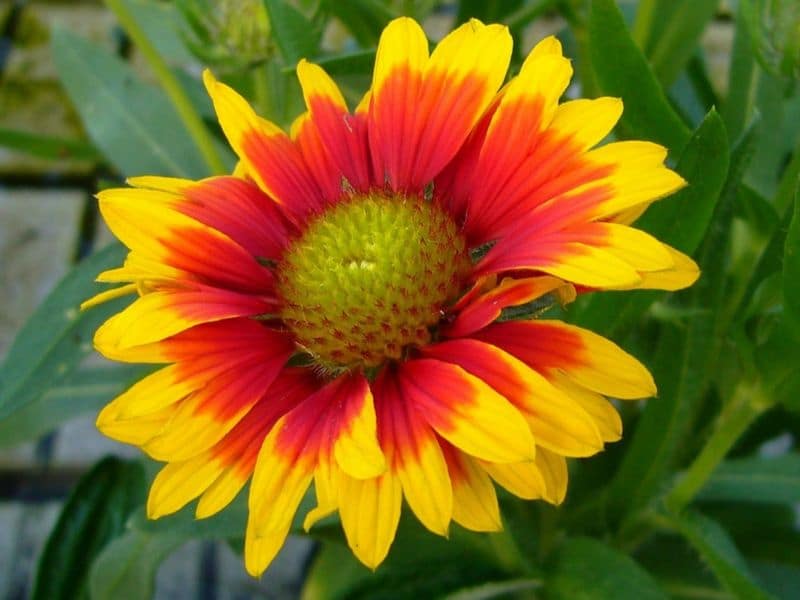
The Gaillardia flowers are also known as blanket flowers. These plants are native to areas of North and South America. The plant belongs to the same family as sunflowers, Asteraceae.
In North America, this showy flower tends to bloom between June and September and can be easy to start from seeds. The blooms are generally yellow, orange, or red, and they have banding at the base of the petals that is usually maroon to orange in color.
Gaillardia flowers typically grow to a height of 2 to 3 feet, and spread up to 2 feet. The flowers need full sun to grow well, and they prefer dry soil. In fact, these plants tend to be very hardy in extreme droughts once they have been established. They do poorly in unamended clay soil. Well-drained soil is a must.
Amaryllis
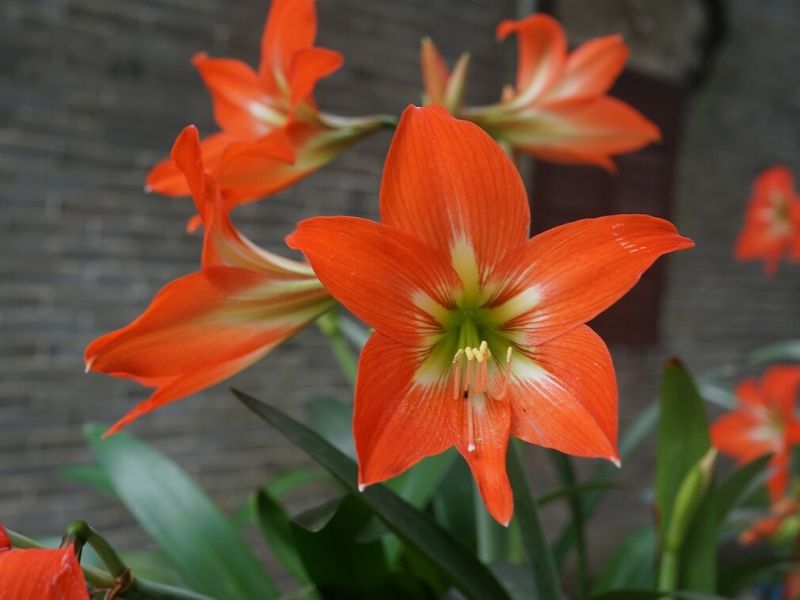
Amaryllis plants are native to Central and South America. They are members of the Amaryllidaceae family and grow from bulbs. Amaryllis grow from 1 to 2 feet in height and spread from 9 to 12 inches. They do well as houseplants and can be planted outdoors during warm seasons.
The Hippeastrum species has been used to develop the hybrid Amaryllis bulb commonly found today. Amaryllis bulbs sprout on a plump hollow stem. Approximately, 6 to 8 flowers will bloom at the top of this leafless stem.
As the flowers mature, large thin leaves grown around the base of the plant. Amaryllis is known for flowers with some banding as well as spotting. Amaryllis colors include white, red and pink.
Caladium Bicolor

Caladium bicolor plants are members of the Arum family and grow from bulbs. Also known as caladiums, heart of Jesus, elephant ear, and angel wings, they are indigenous to Northern South America and Central America.
Caladiums grow to heights between 1 and 2 feet tall with the same spread. Optimum growing conditions include increments of shade, enriched, acidic soil and medium watering. Caladiums grow from tubers and rarely flower.
Flowers are a greenish-white in color. Caladiums are grown for their bright, colorful leaves which often have colored veins. Typical leaf colors include green, white, pink and red with splashes and blotches. Caladiums creative attractive borders and beds.
Chlorophytum Comosum
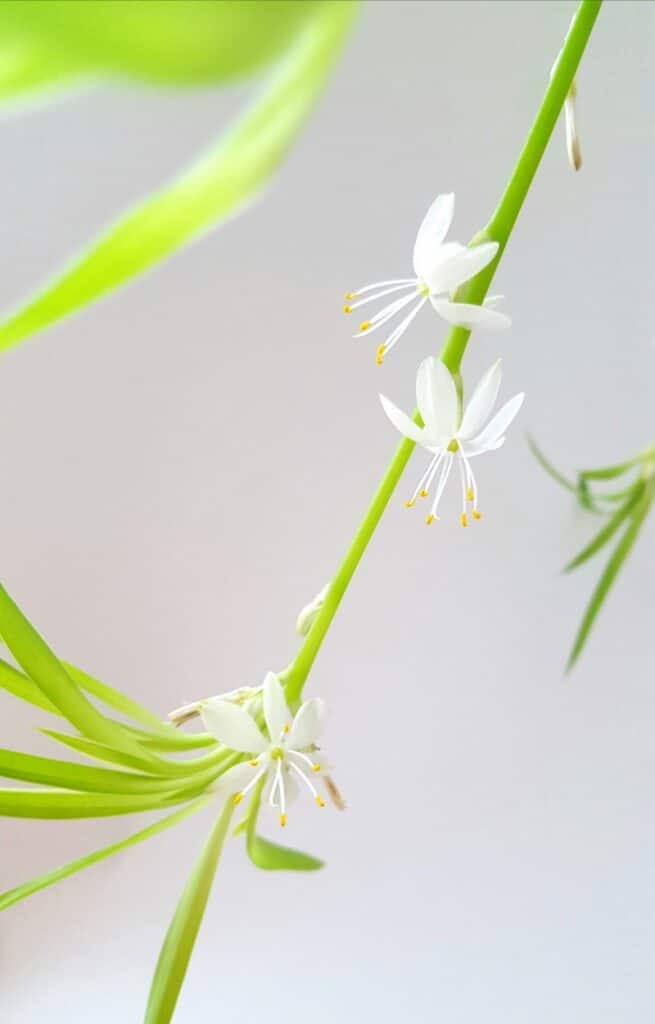
Chlorophytum comosum is commonly called a spider plant and is indigenous to South Africa. Grown from tubers, it is an herbaceous perennial and member of the Asparagaceae family. They are often grown indoors as houseplants.
Spider plants grow from 1 to 2 feet in height with a similar spread. They are considered low maintenance annuals that grow best in light shade in well-draining soil. Spider plants produce leaves of green and white or just green. Make sure to plant them in fertile soil for the best results.
Flowers are tiny, star-shaped, and come in shades of white. The tuberous roots of potted spider plants require division as they continually multiply. Spider plants form plantlets that hang down and create an attractive display.
Yucca Elephantipes
Yucca elephantipes (also known as spineless yucca, yucca gigantea) is a broadleaf evergreen originating in Mexico. It is also known as the spineless yucca or the giant yucca. In its natural habitat, it matures to heights of 30 feet. With age, the trunk broadens, and the bark becomes more rugged or gnarled.
White flowers form in spring through summer. Yucca needs full sun but will tolerate some shade. Spineless yucca is an easy to care for plant that does great in containers. Potted spineless yuccas typically do not bloom.
Yucca elephantipes may be planted outdoors during warm periods. The plant is characterized with bluish-green thin leaves that are blade-shaped. Leaves average about 3 inches in width and grow to lengths of about 4 feet.
Araucaria Heterophylla

Araucaria heterophylla is a coniferous evergreen tree that is indigenous to Norfolk Island, which is near Australia. It is nicknamed the Norfolk Island pine and is a member of the Araucariaceae family.
This needled evergreen does not produce flowers but can be planted from seeds or “terminal cuttings.” The Norfolk Island pine produces male and female seed cones. In its native habitat, the Norfolk Island pine may grow to heights of 200 feet with spreads up to 25 feet. It does well in partial shady locations such as rainforests and has the ability to withstand strong winds.
Ornamental varieties may be planted outside in a warm climate with frost-free areas. Container specimens grow slowly and typically reach between 3 to 6 feet. Norfolk Island pines may great houseplants.
Begonia
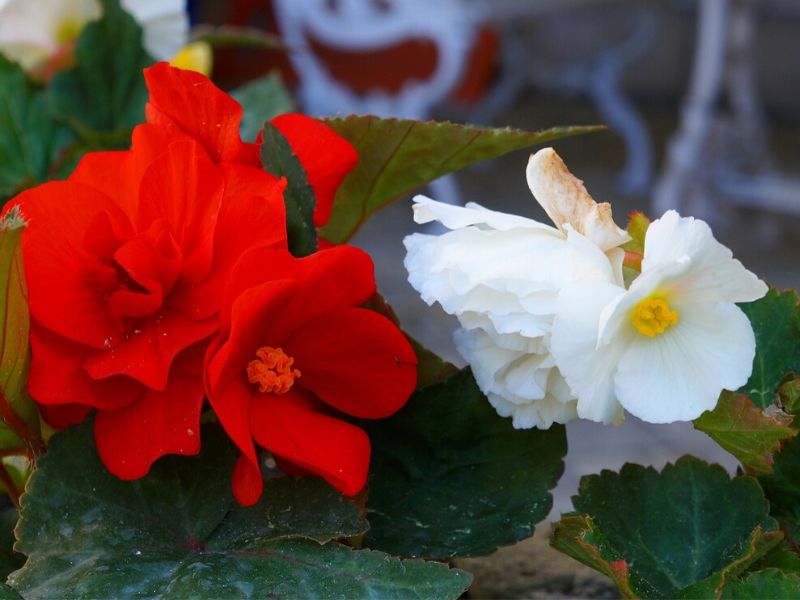
Begonias originated as evergreens in tropical and subtropical areas around the globe. They are members of the Begoniaceae family containing approximately 1,300 species.
In the tropics, begonias range in size from 8 inches to 12 feet in height. They are herbaceous perennials and grow well in sunny locations with some shade.
Starting new begonias is usually by plant division or cuttings from leaves or stems. Ornamental begonias are prized for attractive flowers and striking foliage with exceptional markings.
Begonias range in size from 6 to 12 inches and bloom from early summer until frost. These plants are easy to grow and do well in gardens or containers. Flowers come in bi-colors, pink, red, or white.
Medinilla Magnifica
Medinilla magnifica is also known as rose grape or Showy Medinilla and originated in the Philippines. It is a broadleaf evergreen and member of the Melastomataceae family. Showy Medinilla prefers shady locations and grows in the ground or on trunks of trees.
Considered a shrub, it reaches heights of 4 feet and spreads about 3 feet. Flowers are very attractive and bloom in shades of coral red or pink. Ornamental varieties do well as potted or greenhouse plants.
The leaves are oblong ranging from 8 to 12 inches and colored green with striking veins. Petite, graceful flowers dangle on 18 inch panicles and can be found in shades of coral red or pink.
Calliandra Haematocephala
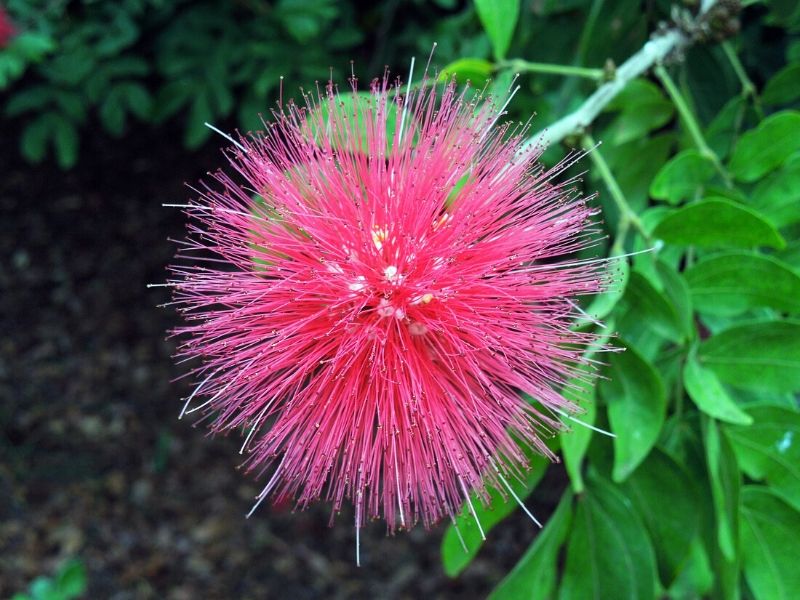
Calliandra haematocephala is a shrub or small tree indigenous to Bolivia. It is a broadleaf evergreen and member of the Fabaceae family. In the tropical locations, Calliandra haematocephala grows to heights of 15 feet.
Nicknamed the powder puff tree, flowers bloom seasonally in bright red hemisphere shapes and have striking scarlet stamens. Ornamental cultivators grow best in containers and require moderate amounts of care.
Plants reach heights of 3 to 6 feet with 2 to 3 foot spreads. Leave emerge as tawny-pink and turn green with maturity. Leaves are bipinnately compound which translates into leaflets that are divided into additional leaflets. Blooms come in the traditional red as well as white and pink.
Zamioculcas Zamiifolia
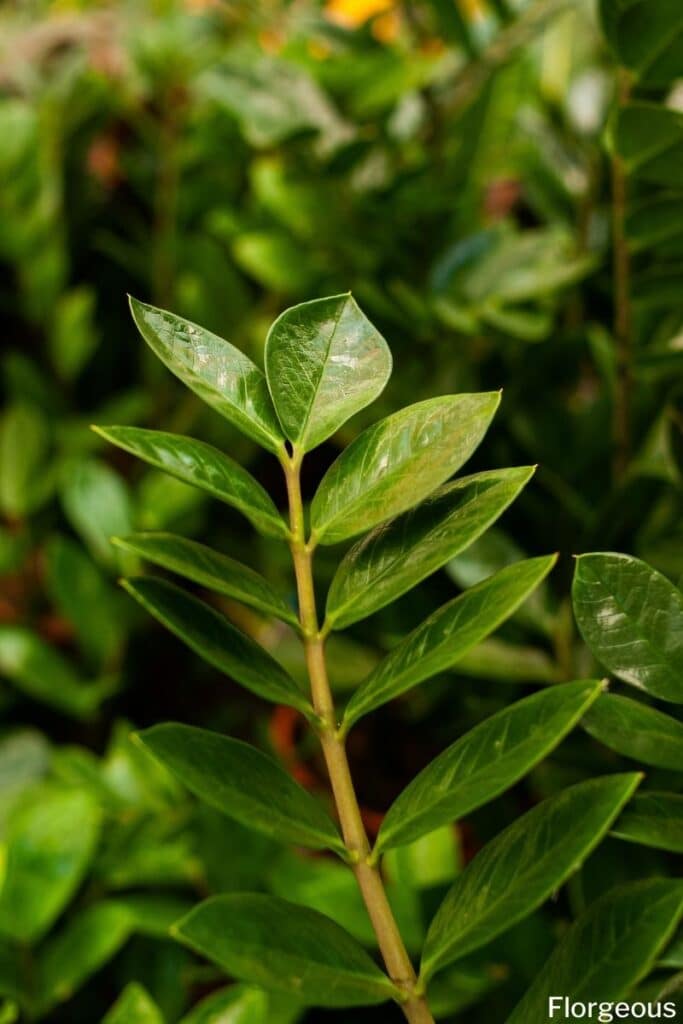
Zamioculcas zamiifolia is commonly called the ZZ plant or aroid palm. Originating in Eastern Africa woodlands and grasslands, it is a member of the Araceae family.
The aroid palm grows well in shady locations and is an herbaceous evergreen perennial. In tropical areas, the aroid palm grows between 2 to 3 feet with a matching spread. It is considered an easy to care for plant.
The Zamoiculas zamiifolia grows from rhizomes and can be started by division or leaf cuttings. Leaves are shiny green leaflets about a half of foot in length. It is a seasonal bloomer producing small ivory flowers on spikes.
Crassula Ovata
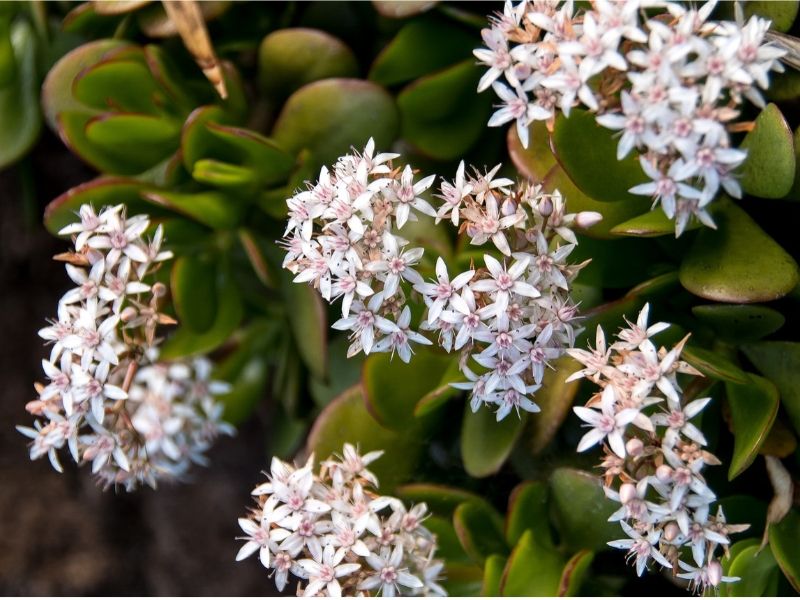
Crassula ovata is a drought resistant broadleaf evergreen and member of the Crassulaceae family. It commonly goes by the name jade plant and is indigenous to South Africa.
In its native surroundings, the jade plant does best with partial shading and occasionally, produces white to pink flowers. It reaches heights up to 6 feet and spreads about 3 feet. Jade plants fall under the category of succulent shrubs.
Ornamental varieties of the jade plant do well as indoor plants and need brightly lit surroundings. They are considered easy to grow. Potted cultivators seldom bloom and grow 18 to 30 inches. Stems resemble tree trucks and support 2 inch long elongated, plump and glossy green leaves.
Epipremnum Aureum

Epipremnum aureum (Devil’s ivy) is indigenous to the Solomon Islands and member of the Araceae family. It is a vine plant that uses aerial roots to cling to and wrap trees with attractive foliage.
Epipremnum aureum also commonly skirts across the ground in lengths reaching 40 feet with spreads ranging from 3 to 6 feet. It is known as devil’s ivy and golden pothos.
This plant is poisonous to humans and animals. Leaves are green and variegated with yellow-marbling and may reach 30 inches in length.
Ornamental varieties reach between 6 to 8 feet and have waxen leaves similar to the philodendron plant. Leaves are mixed with shades of white, green and yellow. Leaves are cordate in shape. Flowering seldom occurs on indoor plants.
Despite the fact that Devil’s ivy is so popular and can be grown everywhere, its flowers are rarely seen because of the shy-flowering nature due to gibberellin (GA) deficiency.
What Are Some Other Tropical Flowering Plants to Grow?
As you may have guessed after reading this round-up of our favorite tropical plants, the list is by no means exhaustive! While these are some of the best tropical flowering plants, there are plenty of others you might want to add to your list.
For example, you may want to grow tropical flowering plants in your tropical garden such as:
- Ginger Plants
- Hibiscus rosa sinensis
- Blood lily
- Chenille plant
- Red hot cattail
- Blue passionflower
- Bougainvillea glabra
- Flamenco vibe
- Protea cynaroides
Any of these would be a great choice for your brightly colored tropical garden!
Which of These Tropical Flowering Plants is Best For You?
Now all that’s left is to decide which of these types of tropical flowers will be best for your garden.
To start, consider your climate. These flowers, as you might expect, are best grown outdoors in tropical and subtropical regions only. But if you’re not lucky enough to live in those tropical climates, that’s okay!
You can easily grow these tropical flowering plants as part of a gorgeous patio and container garden, and simply bring your flowering plant indoors when the weather gets chilly in the early fall.
As long as you have fertile soil, light shade to full sun, and the willingness to pay close attention to your tropical garden, you can grow these plants even in cooler climates.
All that’s left is to pick! With so many tropical flowering plants to choose from, why not pick a few of these ornamental plants to add to your garden? The sky is the limit!
Up Next: 300+ Types of Flowers A to Z
References
Resource List:
http://gardeningsolutions.ifas.ufl.edu/plants/ornamentals/begonias.html
http://www.aos.org/orchids/orchids-a-to-z/letter-p/psychopsis.aspx
https://edis.ifas.ufl.edu/mg106
https://www.ndsu.edu/pubweb/chiwonlee/plsc211/student%20papers/articles04/Olivia%20Tkach/otkach.htm
https://www.nature.com/articles/srep28598
Close

